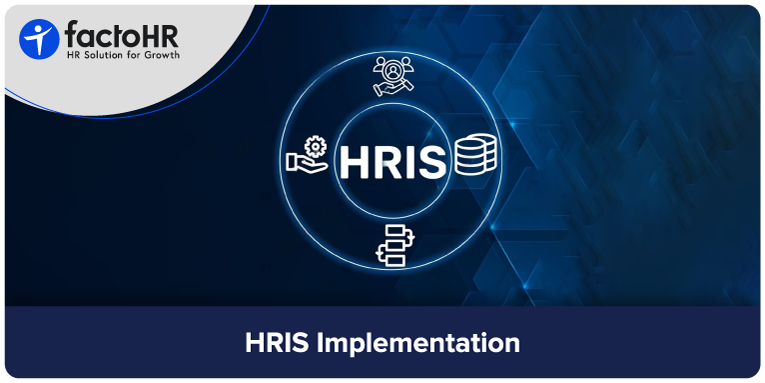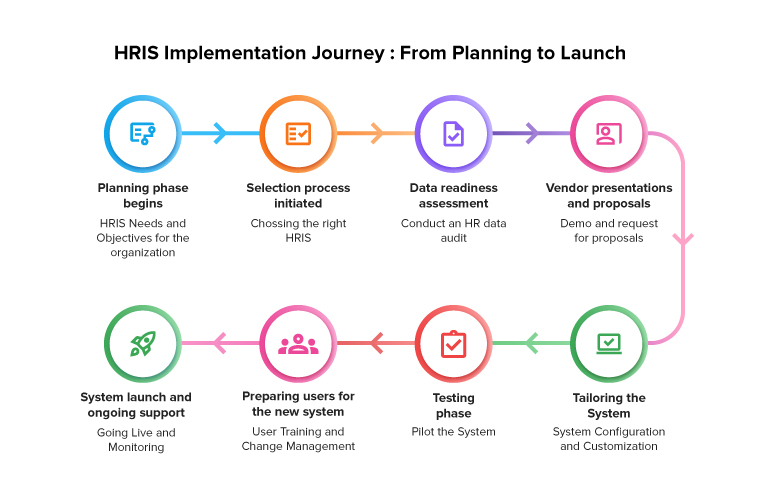HRIS Implementation: Step-by-Step Checklist to Follow

Table of Contents
An efficient Human Resource Information System (HRIS) is one of the most significant pillars of modern HR management. It gives organizations powerful software to streamline operations and manage the workforce more effectively. HRIS is essentially an all-in-one software that combines various HR functions with other tools to automate mundane administrative tasks.
The goal is to streamline every part of the employee life cycle, from hiring to training and performance evaluation to mandates. According to a recent Deloitte study, organizations implementing HR technology effectively saw a 42% increase in staff productivity. So, there is no denying that implementing HRIS systems can help improve employee productivity.
It helps ensure compliance with laws and requirements, enhances data security, and provides high-quality data. Employees also benefit by accessing information, services, and transactions more easily, improving their view of the HR department. This article is a complete guide created by our HR experts to make your HRIS implementation efficient. It covers the steps to implement HRIS systems, the challenges, and their importance.

What is HRIS Implementation?
HRIS implementation is the process of integrating a software solution to manage different HR functions, such as data management, payroll processing, recruitment, performance management, and compliance. It involves evaluating the organization’s existing processes and identifying areas that need improvement. Based on the evaluation, you can choose an HRIS solution provider with a tailored system.
Why is HRIS Implementation Important?
HRIS Implementation is often the key to bringing automation, centralization of data, and real-time insights into your organization’s operations. For instance, you can improve HR policy adherence, automate workflows, and streamline data administration.
Here are some of the benefits of the HRIS and what it has to offer,
Process automation
With HRIS implementation, you can ensure an efficient process and task optimization for your company. It enables your employees to do a particular job in the system without documents. Many HR processes can also be automated, so employees have more time to concentrate on the company’s strategic efforts.
Data centralization
One key benefit of a cloud-based HRIS system is data centralization. An organization can have multiple departments, each with tons of employee data. This platform allows you to centralize data for recruitment, employee productivity, performance evaluations, and payroll processing.
Real-time operational insights
Your organization can benefit from the real-time insights HRIS systems offer to fine-tune workflows. This can help improve productivity and employee performance.

What are the Challenges of HRIS Implementation?
HRIS implementation complexities offer benefits like streamlined HR processes, improved employee data management, and decision-making. However, it becomes more complex due to the same benefits. For example, HRIS offers data management, but ensuring optimal information is secure during the migration to a new system can be complex.
Let’s understand this further, along with other challenges.
- Data migrations- HRIS implementations require you to migrate important information from your existing database to cloud systems. This can lead to data loss, and the cost of information recovery post-migration can be higher.
- Change management- Introducing a new system is not easy for any organization, and if you plan to implement HRIS, you may face the same challenge. Existing employees may also resist the change and training. Managing this resistance and planning the entire HRIS implementation and training modules becomes complex.
- Integration issues- Integrating the HRIS system into existing ones is not easy. Consider an ERP system that you use, and now, if you want to implement HRIS, both systems must be compatible. The environmental configurations, API customizations, and data security policies need alignment.
- Business continuity- Implementing an HRIS system can disrupt the business flow. Your operations can face disruption because you are introducing new systems, migrating data, and implementing new workflows.
- Data Integrity- Changes in data can negatively impact operational efficiency. So, if you want to ensure operational efficiency and data integrity, your HRIS implementations must be strategic. This includes conducting thorough tests before importing all your data into the new HRIS system.
So, how to avoid it?
Here is a series of HRIS implementation steps to overcome these challenges.

What are the Steps of HRIS Implementation?

The deployment of HRIS systems involves custom integrations with HR software solutions to manage various HR functions effectively.
Here are some essential steps to move toward implementation.
Step 1: HRIS Needs and Objectives for the Organization
Implementing a new HRIS system requires a thorough analysis of key organizational goals and objectives because the implementation may not yield the desired results without it. So, how can the HRIS system be aligned with the key objectives?
Here are some of the key questions you need to ask first,
- What are the key HRIS functions you need?
- What are the key challenges of migrating to the new system?
- How many disruptions can it cause to your operations?
- What will be the cost of HRIS implementation?
- How will it impact the core functions and HR tasks?
These questions will help you understand the true objectives of the HRIS implementations.
Step 2: Choosing the Right HRIS
Before deciding on a vendor, you must define what you want in an HRIS system. For example, choosing a cloud HRIS rather than an on-premises HRIS is sensible if you have extensive scalability requirements. Similarly, if you have more sensitive data, your HRIS system must have highly secure data encryption.
A cloud-based human resources information system offers better storage security, scalability, and HR operation flexibility.
Here are some tips on how to select the perfect vendor,
- Evaluate all the vendors in the market.
- Compare vendors based on features, ease of use, and automation capabilities.
- Consider the cost comparison among vendors, including upgrade, maintenance, and support costs.
- Check for integration compatibility with the existing systems.
Step 3: Conduct an HR Data Audit
Before you plan for the HRIS implementation, conduct data audits. These audits ensure your data can be migrated to the new HRIS system. HR audits also enable you to assess the risks of migrating to new systems and determine the recovery systems you need to deploy.
You can create a separate data audit committee that conducts audits, generates reports, and provides in-depth analysis.
Step 4: Demo and Request for Proposal (RFP)
Now that you have finalized a few vendor options, conducted key audits, and are on the verge of making that decision, it’s time to take demos. This will help you experience the HRIS systems firsthand, and you can also ask for proposals from finalized vendor lists.
These proposals can include the system features, objectives it will fulfill, pricing, and the scope of new functionalities.
Step 5: System Configuration & Customization
Next, and one of the most important steps, is to configure your HRIS system according to specific organizational needs. This includes customizing the system so that your tasks can be automated.
Some of the key tips to follow are,
- Set user roles and permissions to ensure data access
- Customize workflows to make sure systems align with the existing workflow.
- Configure all the modules, including payroll processing, training, and other tasks, according to your organization’s needs.
Step 6: Pilot the System
This step is all about running a beta test of sorts. You create a small group of employees to test the HRIS system’s modules and identify areas for improvement..Gather feedback from these groups to understand gaps in usability and data accuracy issues. Lastly, the system will be adjusted based on pilot system feedback from focused groups.
Step 7: User Training and Change Management
Another crucial step you need to complete is training the employees to adopt the HRIS system. Organize workshops and make sure the modules cover all the essential system operations.
Communicate key roles and responsibilities and the benefits of implementing HRIS systems. Document all the sessions to ensure support for new joiners.
Step 8: Going Live and Monitoring
Once the training is complete, you can launch the HRIS system and continuously monitor its performance. You can also measure employee engagement and get feedback on how easy it is to use and if there are any issues. You need a vendor to help you address any technical problems with the HRIS system in real-time.

Conclusion
Using a step-by-step approach to implement an HRIS system helps you transform your HR operations effectively. Start by setting clear goals and choosing the right HR software. Then, conduct data audits and provide training for users. This process ensures that the system works well without causing too many disruptions. Implementing an HRIS can be difficult.
factoHR can help you with a tailored solution for your business that is scalable, secure, and aligns with organizational goals. Request a demo today to see how our easy-to-use platform and dedicated support for implementation can simplify your HR processes.
What are the Common Mistakes to Avoid in HRIS Implementation?
Insufficient planning and preparation for HRIS implementation, with no clear objectives, may cause costly errors and inefficiencies. Ignoring stakeholder buy-in from different departments typically leads to resistance in adoption, while poor data cleansing brings about long-term issues with reporting accuracy and operational efficiency.
Can HRIS Systems Integrate with Payroll or Other Tools?
Insufficient planning and preparation for HRIS implementation, with no clear objectives, may cause costly errors and inefficiencies. Ignoring stakeholder buy-in from different departments typically leads to resistance in adoption, while poor data cleansing brings about long-term issues with reporting accuracy and operational efficiency.
How Can I Prepare My Data for HRIS Migration?
Start by conducting a thorough data audit to find all sources of information. Remove any duplicates and format everything according to legal standards. Clean up any invalid information before you map it to the new system. Create clear field mappings and test them using sample imports.
Grow your business with factoHR today
Focus on the significant decision-making tasks, transfer all your common repetitive HR tasks to factoHR and see the things falling into their place.

© 2025 Copyright factoHR


